
EC600a1 In Situ Raman Test Cell | ||||
Product code | Product Image | Product Features | Product description | Remark |
| 28012001-1 | 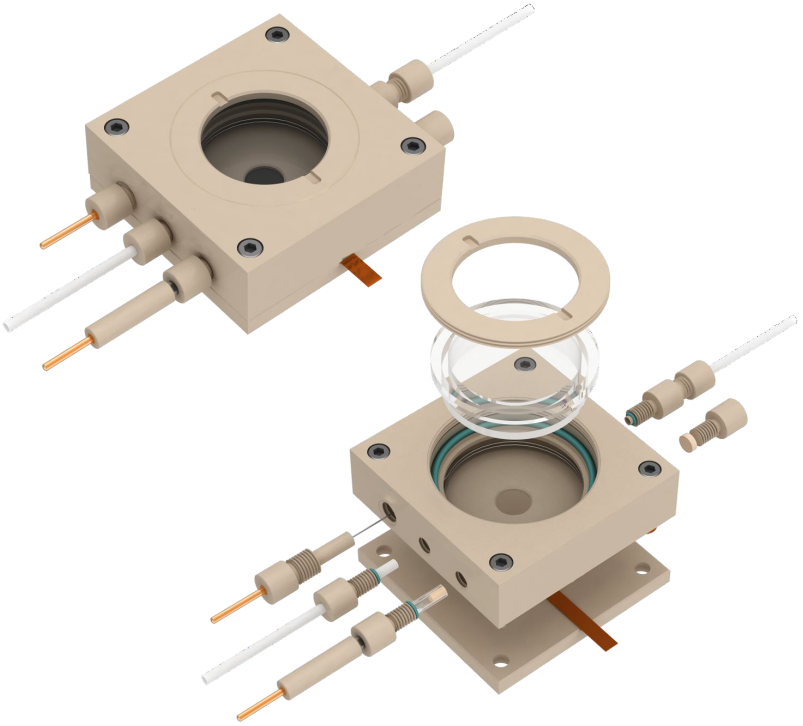 | The in situ electrochemical cell is designed to study the in situ spectral and morphological changes of electrode materials in electrochemical experiments. The working electrode (WE) is placed directly below the fluoroscopy window. This enables optical instruments to observe the working electrode through the quartz window. The electrochemical cell body is made of PEEK material; it can be quickly assembled and disassembled for easy cleaning. The electrochemical cell can be used for in-situ electrochemical testing of the flow system, and can also be simply filled with electrolyte by injection. Light window diameter: 37mm Distance from working electrode to light window:<6mm Working electrode area 1cm2; can be customized upon request The working electrode of this electrochemical cell is a sheet electrode (gold sheet platinum sheet, glassy carbon sheet, ITO, FTO, carbon paper, etc.), which needs to be purchased separately. | Basic type | -- |
| 28012001-2 | 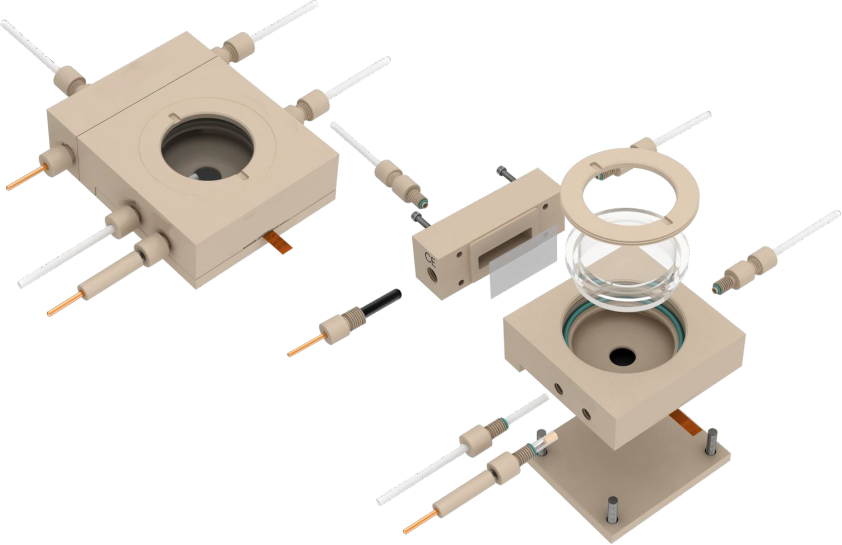 | 2H replaceable membrane type | The two chambers of the electrochemical cell are sealed and connected by screws to facilitate the replacement of the diaphragm. The cathode chamber and the anode chamber are isolated by an ionic membrane (provided by the user), which effectively avoids the impact of the anode on the cathode. The reference electrode of the electrochemical cell is in the same chamber as the working electrode, which effectively reduces the R drop. | |
| 28012001-3 | 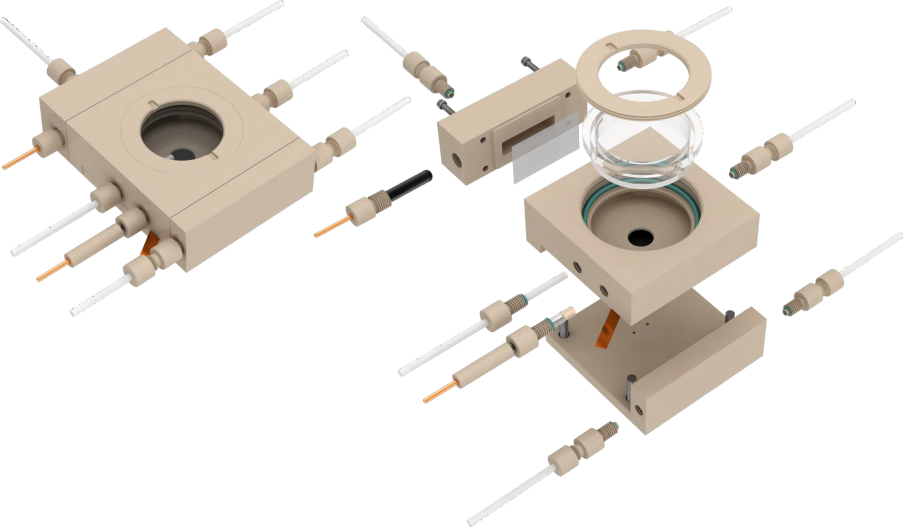 | 3H gas diffusion type | The two chambers of the electrochemical cell are sealed and connected by screws to facilitate the replacement of the diaphragm. The cathode chamber and the anode chamber are isolated by an ionic membrane (provided by the user), which effectively avoids the impact of the anode on the cathode. The electrochemical cell adds a gas channel in the lower layer of the cathode chamber, so that the electrochemical cell has a gas diffusion function. The reference electrode of the electrochemical cell is in the same chamber as the working electrode, which effectively reduces the R drop. The working electrode is usually a gas diffusion electrode to be used with the gas channel | |
| 28012001-4 | 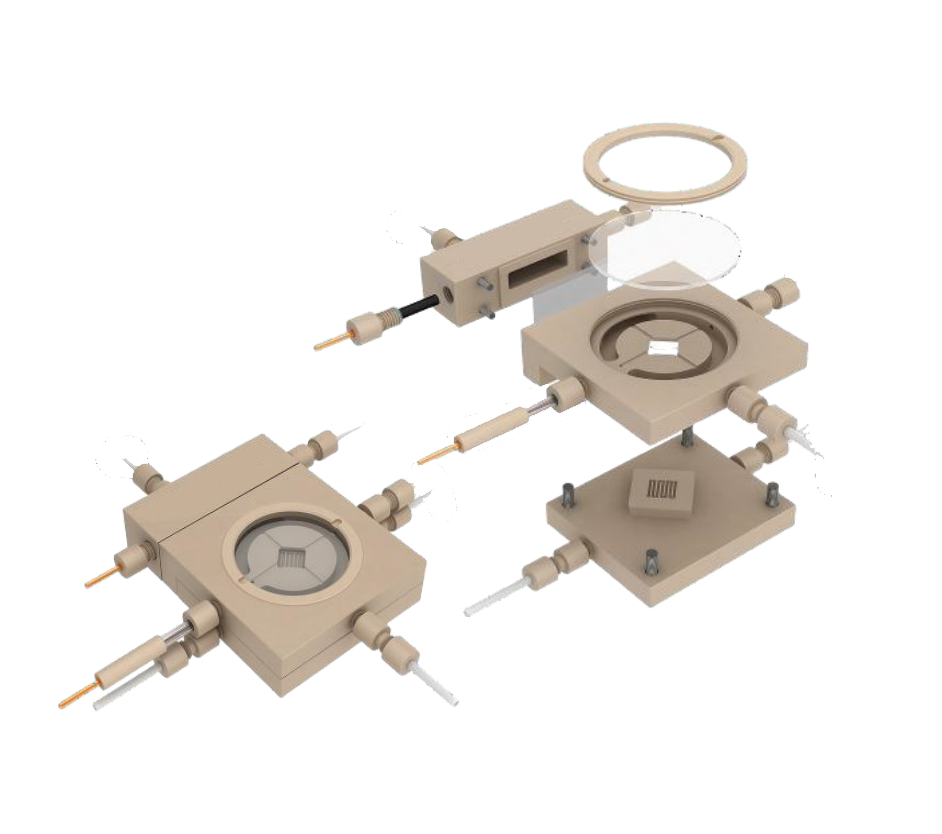 | The in situ electrochemical cell is designed to study the in situ spectral and morphological changes of electrode materials in electrochemical experiments. The working electrode (WE) is placed directly below the see-through window, allowing optics to see the working electrode through the quartz window. The electrochemical cell has three chambers: a gas chamber, a working electrode chamber, and a control electrode chamber. The three chambers are isolated from each other by gas diffusion electrodes (self-provided) and ion membranes (self-provided), which are mainly used for in-situ Raman testing of gas diffusion electrodes. The gas chamber adopts a serpentine flow field, which greatly increases the contact time between the gas and the gas diffusion electrode compared with the 28012001-3 cell, and the catalytic reaction is more sufficient. The working electrode of the 28012001-3 Raman spectroelectrochemical cell adopts a gas diffusion electrode (self-provided), the positioning area is 1cm2, and the imported flat sapphire window is used, and the transmittance can reach more than 95%; the diameter of the plane window is 45mm, and the distance from the window surface to work The electrode distance is less than 3mm, and the extreme design makes this Raman cell applicable to most Raman spectrometers; the reference electrode (standard AgCI or Ag+ electrode) is in the same room as the working electrode, which effectively reduces the R drop. Tank body material: Polyesterone (PEEK) Window Material: Sapphire Window Diameter: 45mm The working electrode is usually a gas diffusion electrode to match the gas channel, and sheet materials such as metal sheet, glassy carbon sheet, ITO, FTO can also be used as the working electrode. Working electrode material to be purchased separately. Default standard AgCl reference electrode and imported graphite rod counter electrode; can be replaced with ag+ reference electrode and platinum wire counter electrode without price difference. | Gas Diffusion - Serpentine Gas Path Type | ---- |
| 28012001-5 | 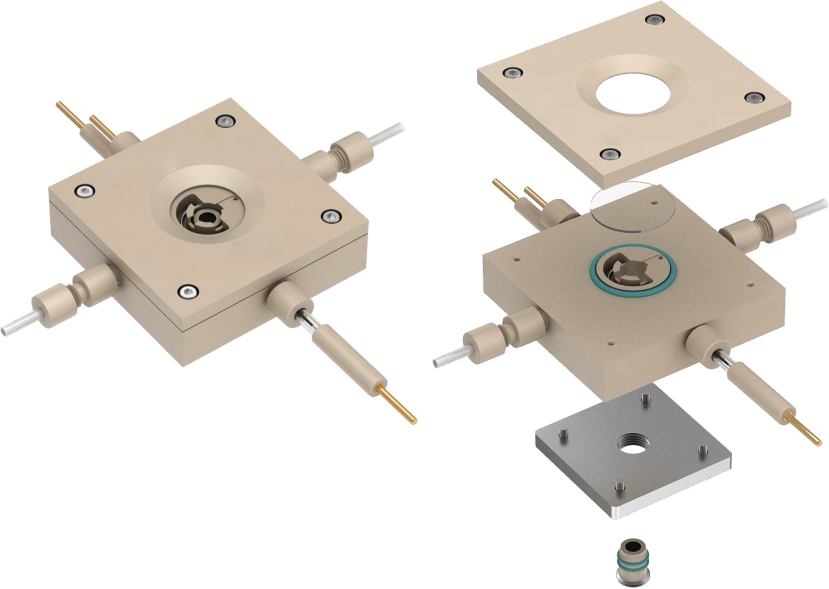 | In situ electrochemical cells are designed to study the in situ spectral and morphological changes of electrode materials in electrochemical experiments. The working electrode (WE) is placed directly below the fluoroscopy window. This enables optics to see the working electrode through the quartz window The main body of the electrochemical cell is made of PEEK and high-purity titanium; it can be quickly assembled and disassembled for easy cleaning. The electrochemical cell can be used for in-situ electrochemical testing of the flow system, and can also be simply filled with electrolyte by injection. Light window diameter: 25mm Distance from working electrode to light window:<6mm The standard working electrode is a 5mm glassy carbon electrode; disk electrodes such as gold disk, platinum disk, and silver disk can be replaced according to requirements (if there is a price difference, the price difference needs to be paid) Standard reference electrode (AgCl or Ag+ electrode) and counter electrode (platinum wire electrode). | Disc electrode | -- |
| 28012001-6 | 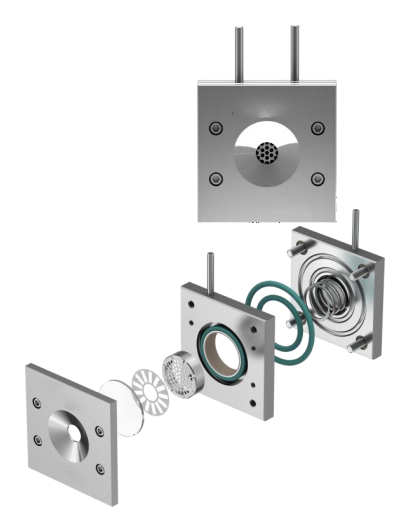 | In situ Raman electrochemical cells are designed to study the in situ spectral and morphological changes of electrode materials in electrochemical experiments. The electrochemical cell is made of high-purity titanium The electrochemical cell has positive and negative poles separated by a membrane (user-supplied) The electrochemical cell has excellent sealing and assembly reproducibility The electrochemical cell can be evaluated by changing the load using a spring. The electrochemical cell can be used in a wide range of battery cycling and characterization tests by connecting to a charge/discharge device. The cell is airtight with an O-ring with excellent chemical resistance by simply tightening the screw. The electrochemical cell can be used in the open air after being assembled in a glove box. The electrochemical cell is easily removable and can be removed after charge/discharge testing without damaging the sample. The electrochemical cell can be quickly assembled and disassembled for easy cleaning. The distance between the working electrode of the electrochemical cell and the light window:<2mm The diameter of the light window of the electrochemical cell: 8mm The length*width*height of the electrochemical cell: 50*50*20mm | Two-electrode battery | -- |
| 28012001-7 | 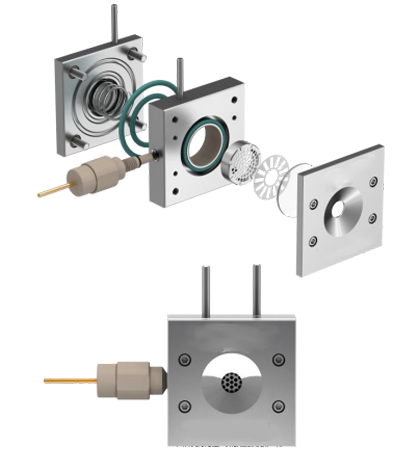 | Three-electrode battery | This electrochemical cell adds a reference electrode to the 28012001-6 | |
| 28012001-8 | 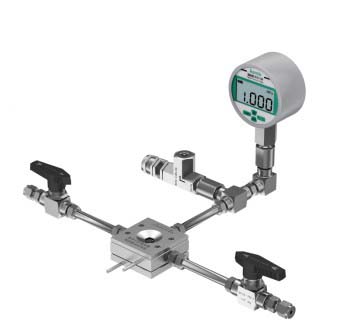 | The electrochemical cell adds a pressure system on the basis of 28012001-6, and the maximum pressure is 6MPa. The in situ Raman electrochemical cell is designed to study the in situ spectral and morphological changes of electrode materials in electrochemical experiments. The electrochemical cell is made of high-purity titanium The electrochemical cell has positive and negative poles separated by a membrane (user-supplied) The electrochemical cell has excellent sealing and assembly reproducibility The electrochemical cell can be evaluated by changing the load using a spring. The electrochemical cell can be used in a wide range of battery cycling and characterization tests by connecting to a charge/discharge device The cell is airtight with an O-ring with excellent chemical resistance by simply tightening the screw. The electrochemical cell can be used in the open air after being assembled in a glove box. The electrochemical cell is easily removable and can be removed after charge/discharge testing without damaging the sample. Electrochemical cells can be quickly assembled and disassembled for easy cleaning. The distance between the working electrode of the electrochemical cell and the light window:<2mm The diameter of the light window of the electrochemical cell: 8mm The length*width*height of the electrochemical cell: 50*50*24mm | Pressure two-electrode battery | -- |
| 28012001-9 | 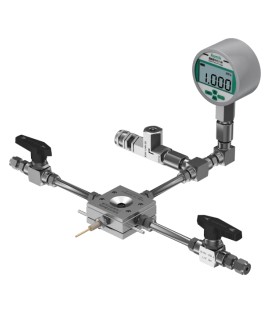 | Pressure three-electrode battery | -- | |
| SCI Materials Hub is Committed to Offering The Best Price & Customer Services! | ||||
For international orders, please ask us for quotes via
Email: contact@scimaterials.cn
Tel: +86 153-5789-9751
Clik here to put quick orders on our Alibaba shop
EC600a1 In Situ Raman Test Cell | |||
Product code | Product description | Price | Delivery date |
| 28012001-1 | Basic type | $1440/pc | Ask for quote |
| 28012001-2 | 2H replaceable membrane type | $1904/pc | Ask for quote |
| 28012001-3 | 3H gas diffusion type | $2464/pc | Ask for quote |
| 28012001-4 | Gas Diffusion - Serpentine Gas Path Type | $2464/pc | Ask for quote |
| 28012001-5 | Disc electrode | $1440/pc | Ask for quote |
| 28012001-6 | Two-electrode battery | $1440/pc | Ask for quote |
| 28012001-7 | Three-electrode battery | $1456/pc | Ask for quote |
| 28012001-8 | Pressure two-electrode battery | $3588/pc | Ask for quote |
| 28012001-9 | Pressure three-electrode battery | $3588/pc | Ask for quote |
| SCI Materials Hub is Committed to Offering The Best Price & Customer Services! | |||
- The price listed above is in U.S. dollars
Worldwide shipping via DHL, SF-Express, FedEx, TNT & other requested carriers.
Payments via Bank Transfer, Paypal, Credit card (via Alibaba), Alipay, Wechat-pay are accepted.
Please contact us for larger quantities or becoming our distributors.
Partial references citing our materials (from Google Scholar)

Carbon Dioxide Reduction
1. ACS Nano Strain Relaxation in Metal Alloy Catalysts Steers the Product Selectivity of Electrocatalytic CO2 Reduction
The bipolar membrane (Fumasep FBM) in this paper was purchased from SCI Materials Hub, which was used in rechargeable Zn-CO2 battery tests. The authors reported a strain relaxation strategy to determine lattice strains in bimetal MNi alloys (M = Pd, Ag, and Au) and realized an outstanding CO2-to-CO Faradaic efficiency of 96.6% with outstanding activity and durability toward a Zn-CO2 battery.
2. Front. Chem. Boosting Electrochemical Carbon Dioxide Reduction on Atomically Dispersed Nickel Catalyst
In this paper, Vulcan XC-72R was purchased from SCI Materials Hub. Vulcan XC 72R carbon is the most common catalyst support used in the anode and cathode electrodes of Polymer Electrolyte Membrane Fuel Cells (PEMFC), Direct Methanol Fuel Cells (DMFC), Alkaline Fuel Cells (AFC), Microbial Fuel Cells (MFC), Phosphoric Acid Fuel Cells (PAFC), and many more!
3. Adv. Mater. Partially Nitrided Ni Nanoclusters Achieve Energy-Efficient Electrocatalytic CO2 Reduction to CO at Ultralow Overpotential
An AEM membrane (Sustainion X37-50 Grade RT, purchased from SCI Materials Hub) was activated in 1 M KOH for 24 h, washed with ultra-purity water prior to use.
4. Adv. Funct. Mater. Nanoconfined Molecular Catalysts in Integrated Gas Diffusion Electrodes for High-Current-Density CO2 Electroreduction
In this paper (Supporting Information), an anion exchanged membrane (Fumasep FAB-PK-130 obtained from SCI Materials Hub (www.scimaterials.cn)) was used to separate the catholyte and anolyte chambers.
SCI Materials Hub: we also recommend our Fumasep FAB-PK-75 for the use in a flow cell.
5. Appl. Catal. B Efficient utilization of nickel single atoms for CO2 electroreduction by constructing 3D interconnected nitrogen-doped carbon tube network
In this paper, the Nafion 117 membrane was obtained from SCI Materials Hub.
In this paper, Proton exchange membrane (Nafion 117), Nafion D520, and Toray 060 carbon paper were purchased from SCI Materials Hub.
7. National Science Review Confinement of ionomer for electrocatalytic CO2 reduction reaction via efficient mass transfer pathways
An anion exchange membrane (PiperION-A15-HCO3) was obtained from SCI Materials Hub.
8. Catalysis Communications Facilitating CO2 electroreduction to C2H4 through facile regulating {100} & {111} grain boundary of Cu2O
Carbon paper (TGPH060), membrane solution (Nafion D520), and ionic membrane (Nafion N117) were obtained from Wuhu Eryi Material Technology Co., Ltd (a company under SCI Materials Hub).
Batteries
1. J. Mater. Chem. A Blocking polysulfides with a Janus Fe3C/N-CNF@RGO electrode via physiochemical confinement and catalytic conversion for high-performance lithium–sulfur batteries
Graphene oxide (GO) in this paper was obtained from SCI Materials Hub. The authors introduced a Janus Fe3C/N-CNF@RGO electrode consisting of 1D Fe3C decorated N-doped carbon nanofibers (Fe3C/N-CNFs) side and 2D reduced graphene oxide (RGO) side as the free-standing carrier of Li2S6 catholyte to improve the overall electrochemical performance of Li-S batteries.
This paper used more than 10 kinds of materials from SCI Materials Hub and the authors gave detailed properity comparsion.
The commercial IEMs of Fumasep FAB-PK-130 and Nafion N117 were obtained from SCI Materials Hub.
Gas diffusion layers of GDL340 (CeTech) and SGL39BC (Sigracet) and Nafion dispersion (Nafion D520) were obtained from SCI Materials Hub.
Zn foil (100 mm thickness) and Zn powder were obtained from the SCI Materials Hub.
Commercial 20% Pt/C, 40% Pt/C and IrO2 catalysts were also obtained from SCI Materials Hub.
3. Journal of Energy Chemistry Vanadium oxide nanospheres encapsulated in N-doped carbon nanofibers with morphology and defect dual-engineering toward advanced aqueous zinc-ion batteries
In this paper, carbon cloth (W0S1011) was obtained from SCI Materials Hub. The flexible carbon cloth matrix guaranteed the stabilization of the electrode and improved the conductivity of the cathode.
4. Energy Storage Materials Defect-abundant commercializable 3D carbon papers for fabricating composite Li anode with high loading and long life
The 3D carbon paper (TGPH060 raw paper) were purchased from SCI Materials Hub.
5. Nanomaterials A Stable Rechargeable Aqueous Zn–Air Battery Enabled by Heterogeneous MoS2 Cathode Catalysts
Nafion D520 (5 wt%), and carbon paper (GDL340) were received from SCI-Materials-Hub.
Carbon cloth (W0S1011) and other electrochemical consumables required for air cathode were provided by SCI Materials Hub.
Oxygen Reduction Reaction
1. J. Chem. Eng. Superior Efficiency Hydrogen Peroxide Production in Acidic Media through Epoxy Group Adjacent to Co-O/C Active Centers on Carbon Black
In this paper, Vulcan XC 72 carbon black, ion membrane (Nafion N115, 127 μL), Nafion solution (D520, 5 wt%), and carbon paper (AvCarb GDS 2230 and Spectracarb 2050A-1050) were purchased from SCI Materials Hub.
2. Journal of Colloid and Interface Science Gaining insight into the impact of electronic property and interface electrostatic field on ORR kinetics in alloy engineering via theoretical prognostication and experimental validation
The 20 wt% Pt3M (M = Cr, Co, Cu, Pd, Sn, and Ir) were purchased from SCI Materials Hub. This work places emphasis on the kinetics of the ORR concerning Pt3M (M = Cr, Co, Cu, Pd, Sn, and Ir) catalysts, and integrates theoretical prognostication and experimental validation to illuminate the fundamental principles of alloy engineering.
Water Electrolysis
1. International Journal of Hydrogen Energy Gold as an efficient hydrogen isotope separation catalyst in proton exchange membrane water electrolysis
The cathodic catalysts of Pt/C (20 wt%, 2–3 nm) and Au/C (20 wt%, 4–5 nm) were purchased from SCI Materials Hub.
2. Small Science Silver Compositing Boosts Water Electrolysis Activity and Durability of RuO2 in a Proton-Exchange-Membrane Water Electrolyzer
Two fiber felts (0.35 mm thickness, SCI Materials Hub) were used as the porous transport layers at both the cathode and the anode.
3. Advanced Functional Materials Hierarchical Crystalline/Amorphous Heterostructure MoNi/NiMoOx for Electrochemical Hydrogen Evolution with Industry-Level Activity and Stability
Anion-exchange membrane (FAA-3-PK-130) was obtained from SCI Materials Hub website.
Fuel Cells
1. Polymer Sub-two-micron ultrathin proton exchange membrane with reinforced mechanical strength
Gas diffusion electrode (60% Pt/C, Carbon paper) was purchased from SCI Materials Hub.
Characterization
1. Chemical Engineering Journal Electrochemical reconstitution of Prussian blue analogue for coupling furfural electro-oxidation with photo-assisted hydrogen evolution reaction
An Au nanoparticle film was deposited on the total reflecting plane of a single reflection ATR crystal (SCI Materials Hub, Wuhu, China) via sputter coater.

|
We Provide A Broad Range of Materials, Instruments & Solutions in Advanced Science and Technologies | About Us |



